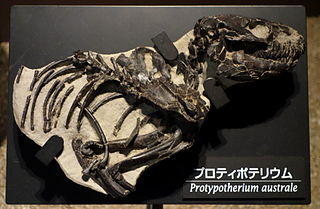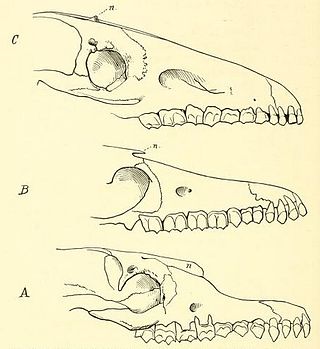
Caiman is a genus of caimans within the alligatorid subfamily Caimaninae. They inhabit Central and South America. They are relatively small sized crocodilians, with all species reaching lengths of only a couple of meters and weighing 6 to 40 kg on average.

Phoberomys is an extinct genus of rodents. Fossil specimens from the Late Miocene period have been discovered in the Ituzaingó Formation of Argentina, the Solimões Formation of Brazil, the Urumaco Formation at Urumaco in Venezuela, and the Pliocene of Peru.

Protypotherium is an extinct genus of notoungulate mammals native to South America during the Oligocene and Miocene epochs. A number of closely related animals date back further, to the Eocene. Fossils of Protypotherium have been found in the Deseadan Fray Bentos Formation of Uruguay, Muyu Huasi and Nazareno Formations of Bolivia, Cura-Mallín and Río Frías Formations of Chile, and Santa Cruz, Salicas, Ituzaingó, Aisol, Cerro Azul, Cerro Bandera, Cerro Boleadoras, Chichinales, Sarmiento and Collón Curá Formations of Argentina.
Paranauchenia is an extinct genus of South American litopterns belonging to the family Macraucheniidae. It is known only from fossil finds in Argentina. It possessed three toes and long limbs. The species Paranauchenia denticulata lived in the Miocene epoch in Argentina. Fossils have been found in the Arroyo Chasicó and Ituzaingó Formations of Argentina.
The Neoepiblemidae are an extinct family of hystricognath rodents from South America. The genera Dabbenea and Perumys are now included in Phoberomys. The delineation between Neoepiblemidae and Dinomyidae has historically been unclear, with some genera having varying taxonomic placement. A 2017 study found Phoberomys to be part of the group, while Eusigmomys was found to be part of the Dinomyidae.

Scalabrinitherium is an extinct genus of mammals of the family Macraucheniidae. Fossils of this animal were found among the fossils of prehistoric xenarthrans in the Ituzaingó Formation of Argentina.

Eumegamys is an extinct genus of dinomyid rodent from the late Miocene and Pliocene of Brazil, Venezuela and Argentina in South America. Its skull was 50 cm long.
The Huayquerian age is a period of geologic time within the Late Miocene epoch of the Neogene, used more specifically within the SALMA classification. It follows the Chasicoan and precedes the Montehermosan age.

Eleutherocercus was a genus of glyptodonts that lived during the Late Miocene and Early Pliocene in South America. Fossils of the genus have been found in the Huayquerian Ituzaingó Formation and the Montehermosan Monte Hermoso Formation in Argentina.
Phoberomys insolita is an extinct species of rodent that was known as the largest rodent on earth, before the discovery of Josephoartigasia monesi. Fossil specimens from the Late Miocene period have been discovered in the Ituzaingó Formation of Argentina.
Macranhinga is a genus of extinct darters belonging to the Anhingidae. The type species is M. paranensis, which was described on the basis of complete tarsometatarsi and several dissociated skeletal elements. All the specimens come from the Ituzaingó Formation that crops out discontinuously along the eastern cliffs of the Paraná River in northeastern Argentina, the river from which the specific epithet is derived. The most striking feature of this bird is its large size, much greater than in all other known fossil or extant anhingas.
The Ituzaingó Formation, in older literature also described as Entre Ríos or Entrerriana Formation, is an extensive geological formation of Late Miocene age in the Paraná Basin of the Corrientes, Santa Fe and Entre Ríos Provinces in Mesopotamia, northeastern Argentina. The formation comprises mudstones, cross-bedded sandstones and conglomerates deposited in a fluvio-deltaic environment and is renowned for the preservation of a rich fossil assemblage, including many mammals, birds, reptiles, fish, bivalves, foraminifera, ichnofossils and flora.
Phoberomys burmeisteri is an extinct rodent that lived in the late Miocene of southern South America. It lived in wetland environments, such as swamps and marshes, where it likely fed on aquatic plants and grasses. It was first described in 1884 by the German zoologist Hermann Burmeister, who named the species after himself. Their remains were recovered from the Ituzaingó Formation in Entre Ríos Province, Argentina.
Cullinia is an extinct genus of litoptern, an order of South American native ungulates that included horse-like and camel-like animals such as Macrauchenia. It is only known from fragmentary remains. Cullinia levis is known from Chasicoan remains found in the Arroyo Chasicó Formation of Argentina, and remains from the Brazilian state of Acre and the Huayquerian Ituzaingó Formation have been assigned to Cullinia sp..
Proterotherium is an extinct genus of litoptern mammal of the family Proterotheriidae that lived during the Late Miocene of Argentina and Chile. Fossils of this genus have been found in the Ituzaingó Formation of Argentina, and the Galera Formation of Chile.
Brachytherium is an extinct genus of proterotheriid mammal from the Late Miocene to Late Pliocene of Argentina. It is represented by the type and only species B. cuspidatum, a taxon named in 1883 by Ameghino for a partial mandible with teeth. Though it was considered a dubious taxon at times, Brachytherium was revised as valid by Schmidt in 2015, who also synonymized the species Proterotherium gradatum and Lophogonodon paranensis, expanding the material known, all of which is from the Ituzaingó Formation. Some material previously referred to Brachytherium has been given the new name Neobrachytherium.
Comaphorus is a dubious extinct genus of glyptodont. It lived during the Late Miocene in Argentina, but only one fossil has ever been referred to the animal.
Caiman australis is an extinct species of caiman described in 1858 on the basis of a left maxilla that was collected from the Upper Miocene age Ituzaingó Formation of Entre Rios, Argentina.

Perimys is an extinct genus of neoepiblemid rodent that lived from the Early to Late Miocene in what is now South America. Fossils have been found in the Cerro Bandera, Cerro Boleadoras, Ituzaingó, Santa Cruz, and Sarmiento Formations of Argentina, and the Galera, Santa Cruz and Río Frías Formations of Chile.
The Camacho Formation is a Huayquerian geologic formation in Uruguay.






